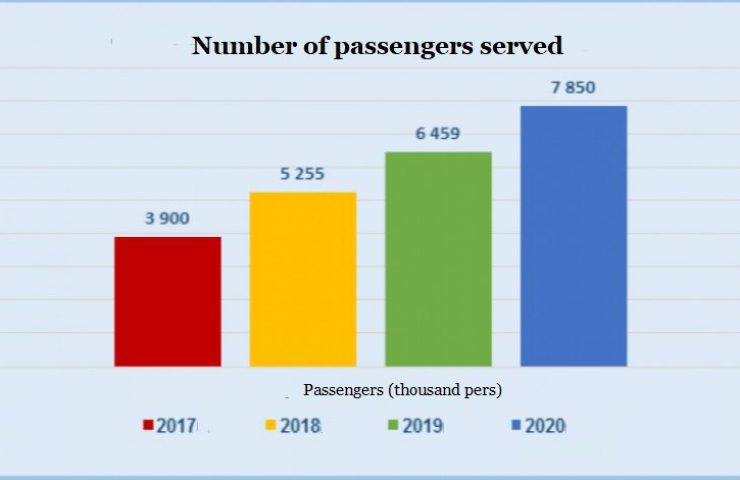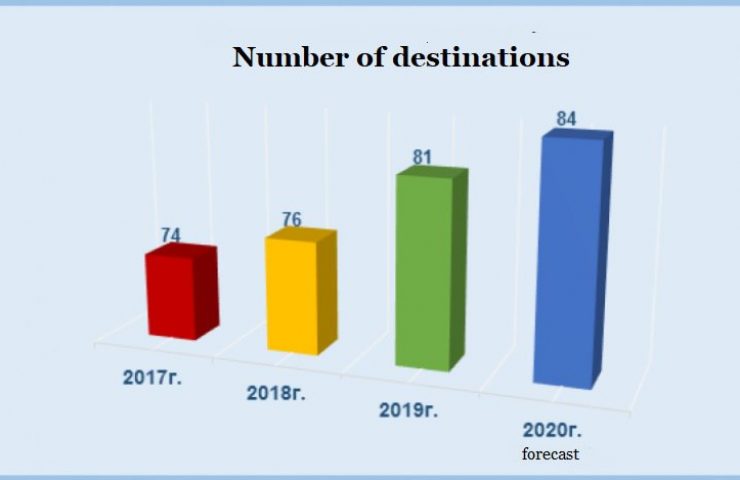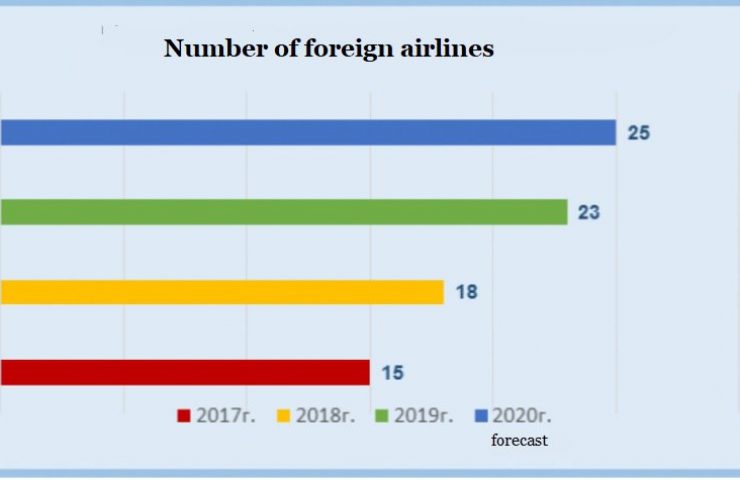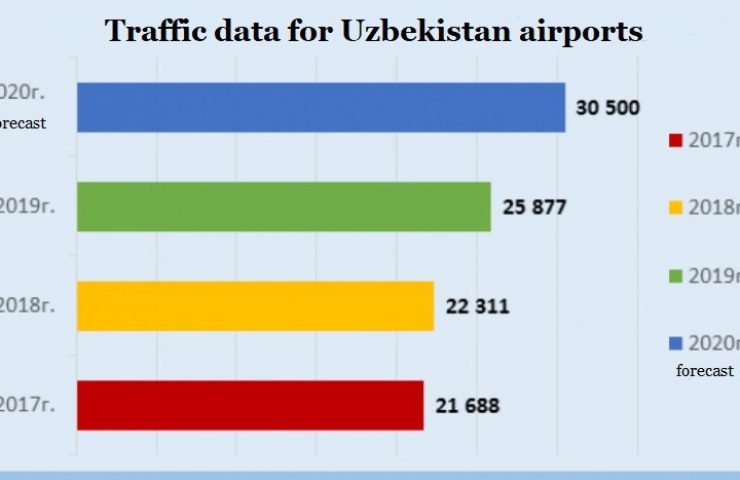“If the government of Uzbekistan truly wished to liberalize the aviation industry, it needs to renounce the support for the national air carrier,” said political economist Bakhrom Radjabov in an article just for CABAR.asia.
Follow us on LinkedIn

We recently learned that the transfer of the state airline Uzbekistan Airways to a foreign company has been discussed at a meeting with the President of Uzbekistan[1]. Apparently, transferring Uzbekistan Airways to a foreign company has become more acute due to the crisis and the airline’s difficult financial situation as the travel slowed by the coronavirus. Though, there were many challenges even before the pandemic. How did it happen and what is a plan for aviation reforms?
As before?
Uzbekistan Airways (Oʻzbekiston havo yoʻllari) has been the only airline on the Uzbek market with 100% state support maintaining a monopoly in the country’s airspace over the years of Uzbekistan’s independence.[2] Then came the trouble with the country’s civil aviation industry that Mirziyoyev’s government started addressing. The main issue on the agenda is liberalizing and introducing competition in that sector. As planned, this should make the field more attractive to foreign investors, lower the prices, and improve the service, as well as turn Uzbekistan into a regional aviation hub.
Generally, there is a big plan to increase passenger traffic to Uzbekistan and thus stimulate the country’s tourism industry.
To help you better understand the current status of the national airline and Uzbekistan’s aviation industry as a whole, we need to determine why this airline was created in the first place. In January 1992, President Islam Karimov signed a decree establishing a national air carrier. The Uzbek part of the former Soviet Aeroflot has become the Uzbekistan Airways. Later in February of that year, the country’s cabinet of ministers approves the goals and objectives of the airline. It is important to recognize that the airline was originally created as a state entity in the field of aviation and was meant to be a non-for-profit[3].
The past three years, however, indicate substantial shifts in the activities of the national airline. As part of the competition development program, the number of foreign airlines operating flights to the republic increased from 15 in 2017 to 23 in 2019.[4] Projective figures for the increase in the number of passengers, flights, foreign airlines and destinations are given below (See infographics). This projection seems to be logical because of the fact that Uzbekistan started opening up to the world, thus increasing the tourist flows. The latter necessitates the aviation sector development.
Source: Uzbekistan AirwaysWhat’s being proposed?
The Uzbekistan Airports, Aviation & Logistics Forum (UAALF), held for the first time in Uzbekistan in February 2020, was organized by the State Committee for Tourism Development, the Ministry of Transport of Uzbekistan and Fair Exhibition.

It was stated that civil aviation was subject to major reforms that have not been implemented for the past 30 years. Among the reforms are:
- The reorganization of Uzbekistan Airways in October 2019 had formed two independent companies – Uzbekistan Airways and Uzbekistan Airports.
- Since October 2019, the “Open Skies” regime using the “fifth air freedom” was introduced at the international airports of Karshi, Nukus, Termez, and Bukhara.
- A new passenger terminal and a runway are to be constructed at Samarkand International Airport, increasing the airport’s carrying capacity from 500 to 1,500 passengers per hour.
The review and reconstruction of the Tashkent International Airport under the German experts’ supervision increase the airport capacity from 4 to 7 million passengers per year.
The construction of a new runway at the Termez international airport and the reconstruction of the Andijan international airport will enable different aircrafts maintenance, while also increasing by 2-3 times the number of flights.[5]
A new uniform of Uzbekistan Airways’ pilots and cabin crew Photo: Uzbekistan AirwaysThe ultimate goal is to increase the passenger flow to Uzbekistan by establishing one prerequisite facilitating the tourism industry development.
- A new Humo Air airline and Uzbekistan Helicopters are being created to broaden the competitive space in this area, meet the needs of passenger services both domestically and throughout the Central Asian region.[6]
- Enhancing the attractiveness of Uzbek airports by reducing aviation fuel prices and airport charges. According to Uzbekistan’s Minister of Transport Elyor Ganiyev, “there has been a substantial decrease in jet fuel prices that are now $ 880 per ton”[7].
Minister Ganiyev also pointed out that “the launch of the Uzbekistan GTL plant in Kashkadarya region, which will produce 1.7 million tons of various fuels, including over 300 thousand tons of jet fuel, diesel, and gasoline, will be essential for the aviation fuel market. “[8] “There will be a control over the jet fuel prices so that they are not higher than the regional average. This will promote competition. “[9] It looks like a good start at first glance, but what’s the problem, then?
What’s the problem? Too much of a state
Uzbekistan has far failed to discard a big share of state presence in the economy. Economist Yuli Yusupov writes: “The share of state-owned companies in the country’s GDP is 55%. This indicator is 35% in Russia and 15% in Singapore; the average value for the state shares in developed countries is 20–25%.” This and a big share of the state budget in the country’s GDP indicate that Uzbekistan is yet to transition to the market economy.[10]
Little has changed in civil aviation, too. Despite the government’s ambitions to develop low-cost airline services, there is not much of an excitement.
As previously mentioned, aviation in Uzbekistan used to belong to one state-owned enterprise Oʻzbekiston havo yoʻllari. The Government decided to reorganize and form Uzbekistan Airways and Uzbekistan Airports to separate the functions of air travel and airport servicing. The restructuring efforts were not, however, well received by investors disrupting the state’s expectations.

According to Alisher Annazarov, the head of SilkJet, this further hindered the demonopolization of the aviation industry in Uzbekistan. The former national air carrier remained on the market but this time dividing a monopoly into parts and allocating responsibility to each enterprise[11]. Annazarov believes there is no sign of demonopolization in the aviation industry for investors and no guarantee that the newly-emerged private airline won’t be infringed by a state-owned company.[12]
For instance, the Humo Air, being a state airline, will directly report to the Uzbekistan Ministry of Transport. The Government’s view was to make short distances domestic flights possible. The company won’t become a competitor to Uzbek national airlines. All these efforts are aimed at servicing the estimated increase in passenger traffic that was expected with the influx of tourists into the country.
Uzbekistan Helicopters has recently changed ownership. However, the enterprise was founded by joint-stock companies with the main government share. So, Uzbekistan Airways JSC, established on the basis of the National Airline Directorate and state-owned unitary enterprises “Flight Complex”, “Main Air Communications Agency” and “Uzaviatekhsnab Logistics Supply Complex“, is the founder of Aviation Training Center LLC,“ Uzbekistan Airways Technics ”,“ Uzbekistan Airways Catering ”, as well as “Uzbekistan Helicopters”.[13] The Uzbekistan Helicopters division was founded on the basis of the State Unitary Enterprise “Airline for Special Aircraft Operations”. It will be managed by the Ministry of Transport.[14]
Such facts reasonably cause concern among private investors, as they do confirm the continued state support to the National Air carrier and its affiliated airlines[15].
Uzbekistan Airways continues to receive state aid in the form of state guarantees and various subsidies. It had become imperative especially amid the coronavirus pandemic when nearly all world air carriers suffer enormous losses and turn to creditors and/or their states for help. In the case of the Uzbek national airline, according to international aviation law expert Rakhmad Sobirov, “the difference is that the government of Uzbekistan must rescue only one airline, otherwise the entire aviation sector of the country will collapse.”[16]
According to economist Behzod Khashimov, such support to a state-owned airline or automobile company would be a mistake[17]. Khashimov believes that the impending crisis and related events should serve as a lesson that “state owning numerous enterprises in merely all economic sectors is a bad idea”[18].
It is, therefore, premature of us to expect changes in the tariff policy and the service, since there have been no radical changes made to promote competition in aviation. Besides, the coronavirus pandemic is likely to alter Uzbekistan’s ambitious plans to attract new airlines to the country. On the other hand, the pandemic provides an opportunity for aviation reforms and demonopolization in the industry.[19] Time will tell whether the Government will take this chance.
Open Skies regime isn’t really working yet
Since February 2018, the Government announced the concept of “open skies” at the country’s three airports. The implementation of this concept, and thereby the attraction of greater traffic and passenger traffic to airports, was hindered by circumstances unrelated to the pandemic. For example, the legislation was not prepared for the operation of the low-cost airlines in the country, while the candidate airlines for participation in Uzbekistan’s passenger air travel market had not been consulted with[20].
The two challenges impede the work of foreign low-cost airlines in Uzbekistan, although negotiations are ongoing.
The Uzbek Government says that “Qanot Sharq (another low-cost airline that the Government negotiated with) and SilkJet had shown interest in creating low-cost airlines in Uzbekistan, but lost interest after reports on the launch of the “open skies” regime using the “fifth air freedom”[21].
The Minister of Transport claims that “partners (airlines) got quite scared of competition and thought about the need for such airlines.”[22]
I think that the Uzbek Government, on the one hand, plans to let in at least five to six air carriers in the next two or three years[23], but on the other hand, to hold the leading position of the state airline and make Uzbekistan an air hub. That is the reason for establishing “Humo Air”. The state is in no hurry to terminate the long-standing practice of supporting the national airline, and in fact, continues to invest in it.
How are the neighbors doing?
Kazakhstan has outpaced Uzbekistan introducing the “open skies” regime at its 11 airports and mentions the possibility of signing a multilateral open skies treaty, where any country that meets certain criteria can become a signatory. This is an important step in turning Kazakhstan into an air hub in Central Asia.[24]
Kazakhstan has already initiated a collaboration with a British company to introduce international standards for civil aviation regulation. This will enable Kazakhstan to fast adopt the necessary standards and requirements of the Chicago Convention and ICAO on safety oversight. It is therefore another central aspect of Kazakhstan’s aviation strategy[25].
Most importantly, in May 2019, Kazakhstan’s first low-cost Fly Arystan became operational. There is an enhanced regional service between Kazakhstan’s major cities. Besides, low-cost airlines like Flydubai and Air Arabia, the Turkish low-cost carrier Pegasus Airlines, and the hybrid airline airBaltic operate in Kazakhstan[26]. In May 2020, the Turkish company TAV Airports Holding purchased 100 percent of Almaty International Airport’s shares.
Kyrgyzstan also has a civil aviation development strategy for 2020–2035.[27] It was conceived as a document to tailor the industry to future challenges and frame its future development. It is impossible to prepare the industry for all the challenges, as the crisis caused by the coronavirus pandemic has dramatically illustrated. Such approaches, nevertheless, recognize many factors, from oil prices to world conflicts. Most importantly, the strategy helps to explain civil aviation goals.
The development of civilian air travel in Tajikistan was somewhat similar to the situation in Uzbekistan. There was a single national air carrier, Tajik Air[28], which, operated all domestic flights until recently; still, it operates most domestic passenger and cargo flights. For international flights, the national airline had also no local competitors, mainly competing with foreign airlines. However, since 2008, the private airline Somon Air began operating. This has enhanced competition and led to the reorganization of Tajikistan’s national air carrier in 2009. This allowed Tajikistan to separate the air navigation services, the airport operation, and airline services.
The government of Uzbekistan, apart from other aviation reform plans, intends to replenish its air fleet. Otherwise, according to Deputy Prime Minister Aziz Abdukhakimov: “Uzbekistan will lose the market shares to Kazakhstan, whose fleet currently is several times greater than the Uzbek market “[29]. Although the government claims there are many willing to enter Uzbekistan’s market, it all comes to organizing air travel.[30] Low-cost airlines and strategic investors are not prominent so far.
Findings
The analysis shows that Uzbekistan was somewhat late with the aviation industry reforms, namely, with its market-oriented transformations. The national airline at the beginning of Uzbekistan’s independence was conceived more as a state body rather than a commercial entity capable of profit generation.
This approach had been altered with the advent of the new political leadership in Uzbekistan. Economic priorities began to evolve; the tourism development priority prompted the need to develop the aviation industry and the civilian traffic, in particular. Ambitious goals were set for the entry of a larger number of airlines, promotion of low-cost airlines, and private airlines in the Uzbek market. State-owned air and helicopter companies were created for short domestic flights. The “open skies” regime was announced in several airports in the country.
However, there have been several obstacles to implementing those plans, which had been exacerbated by the pandemic. Besides, for a regional air hub title, Uzbekistan has to compete with Kazakhstan, which is way ahead and has already launched its own low-cost carrier, whilst also introducing international standards and regulations for air travel. Uzbekistan, nevertheless, has an excellent chance to make up lost time, judging by the existing base in the aviation industry.
To that end, the Government needs to consider the following steps:
- If the government of Uzbekistan truly wished to liberalize the aviation industry, it needs to renounce the support for the national air carrier. This is not a popular measure, however, as negotiations with investors and airlines indicate, it would be difficult, if not impossible, to attract them to the local market without curtailing the support.
- Both local and international air carriers need a legislative framework for an “open skies” with clear and transparent rules. Without this measure, and without coordination with candidate airlines, the open sky regime will not bring the expected influx of air carriers and is unlikely to increase the passenger flow to and through Uzbekistan.
- Bearing in mind the competition in the region (with Kazakhstan, for example), Uzbekistan should be more proactive in its efforts. So, Kazakhstan has already “opened the sky”, has a larger number of aircraft and better legislation in this area, while also having an experience in low-cost airlines in the country.
This material has been prepared as part of the Giving Voice, Driving Change – from the Borderland to the Steppes Project. The opinions expressed in the article do not reflect the position of the editorial board or donor.
[1] See Uzbekistan Airways might be transferred to a foreign company, www.gazeta.uz,
[2] See Uzbekistan Airways responded to monopoly and high prices allegations, www.kun.uz,
[3] See www. spot.uz, https://www.spot.uz/ru/2018/09/15/avia-strategy/
[4] See Uzbekistan Civil Aviation Development Reforms, www.uzairways.com, https://www.uzairways.com/en/press-center/news/reformy-v-sfere-razvitiya-grazhdanskoy-aviacii-uzbekistana
[5] See With a Long-Term Perspective, www.pv.uz, https://pv.uz/ru/newspapers/s-dalnim-pritselom
[6] Ibid.
[7] See How airports might become more attractive, www.gazeta.uz,
https://www.gazeta.uz/ru/2020/02/16/airports/
[8] See How airports might become more attractive, www.gazeta.uz,
https://www.gazeta.uz/ru/2020/02/16/airports/
[9] Ibid.
[10] See Announced Wide Privatization Program, www.ced.uz,
[11] See Looking into the future: what awaits the aviation industry of Uzbekistan, www.Uzreport.news,
https://uzreport.news/economy/vzglyad-v-budushee-chto-jdet-aviatsionnuyu-otrasl-uzbekistana
[12] Ibid.
[13] See Uzbekistan Helicopters Have Been Issued Operator Certificate, www.uzdaily.com,
http://www.uzdaily.com/en/post/47551
[14] See “Uzbekistan Airways” finally restructured, www.uz.sputniknews.ru,
https://uz.sputniknews.ru/economy/20191111/12774935/khavo-yullari-restrukturizatsiya.html
[15] See Looking into the Future: what awaits the aviation industry of Uzbekistan, www.Uzreport.news,
https://uzreport.news/economy/vzglyad-v-budushee-chto-jdet-aviatsionnuyu-otrasl-uzbekistana
[16] See www.forbes.uz, https://forbes.uz/finances/investment/kuda_investirovat_v_krizis_v_uzbekistane/?fbclid=IwAR326tdHzjOci2FN2Cm5XPPwVXziDlfaK3fJmKsyerdnvq
[17] See Economic consequences of coronavirus and how to mitigate them, www.gazeta.uz,
https://www.gazeta.uz/ru/2020/03/19/measures/?utm_source=push&utm_medium=telegram
[18] Ibid.
[19] Ibid.
[20] See “Uzbekistan Airways will no longer be a monopolist like it used to” – Elyor Ganiev, www.gazeta.uz,
https://www.gazeta.uz/ru/2020/02/18/airways/
[21] Ibid.
[22] See “Uzbekistan Airways will no longer be a monopolist like it used to” – Elyor Ganiev, www.gazeta.uz, https://www.gazeta.uz/ru/2020/02/18/airways/
[23] Ibid.
[24] See Uzbekistan opens the sky: where will the first reforms of the aviation industry lead to, www.kun.uz,
[25] See Civil Aviation of Kazakhstan adopts the British Flight Regulation Model, www.inform.kz, https://www.inform.kz/ru/grazhdanskaya-aviaciya-kazahstana-perehodit-na-britanskuyu-model-regulirovaniya-poletov_a3578945
[26] See Kazakhstan low-cost airlines, www.flylowcost.kz, https://flylowcost.kz/budget-airlines-kazakhstan.htm
[27] See the Kyrgyz Civil Aviation Development Strategy for 2013-2020, www.caa.kg ,
http://caa.kg/ru/normativnye-dokumenty-kr/strategy-razvitiya-grajdanskoi-aviacii-na-2013-2020/
[28] See Tajikistan Air Transport, tajik-gateway.org, https://www.tajik-gateway.org/wp/transport-tadzhikistana/vozdushnyj-transport-tadzhikistana/
[29] See “If we do not increase the number of aircraft, we can give up the market shares” – Deputy Prime Minister. www.gazeta.uz, https://www.gazeta.uz/ru/2020/02/13/aircrafts/
[30] See 2020 will be a turning point in the development of the aviation industry of Uzbekistan, www.review.uz , https://review.uz/ru/post/2020-god-stanet-perelomnm-v-razvitii-aviacionnoy-otrasli-uzbekistana








